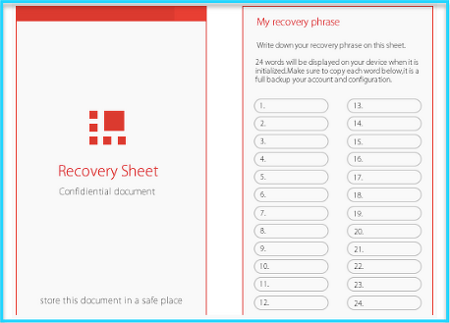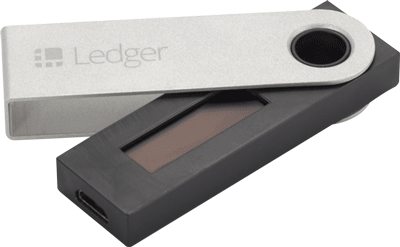
Offline storage means that if your hardware wallet is plugged into a computer infected with malware, your recovery seed and cryptoassets will remain totally secure. The offline storage of the hardware wallet will completely insulate the recovery seed from the infected device.
This means that so long as your recovery phrase is the same, the calculation of the private keys will always have the same result. You can read more about how applications calculate the private keys for each cryptocurrency here. You can’t extract the private keys from your Nano S. Security of the private keys is the reason you use a hardware wallet in the first place. When first getting used to using a hardware wallet, you should put a small amount of bitcoin in the wallet, then wipe it and restore from seed.
In Ledger’s case, it says the majority of its Nano S wallets are sold directly to consumers, but some are sold through third-party retailers. These range from Amazon to small businesses that specialize in cryptocurrency products.
Lost device, PIN code or recovery phrase
In terms of security 12-word recovery seed is safe enough (128 bits of entropy). Seed phrases, like all backups, can store any amount of bitcoins. It’s a concerning idea to possibly have enough money to purchase the entire building just sitting on a sheet of paper without any protection. For this reason many wallets make it possible to encrypt a seed phrase with a password. The Ledger Nano S has been out for a while, while the Safepal is new.
How do I restore my ledger?
When you setup a Trezor, Ledger or Keepkey hardware wallet, you will be required to write down a recovery seed. The recovery seed, also known as a recovery phrase, backup phrase or word seed is a list of 12, 18 or 24 words that store all the information needed to recover your wallet.
Larger Than Ledger
Recovery phrases, also known as Seed Phrases, are absolutely vital in using a hardware wallet. If for any reason your Ledger Nano X or Ledger Nano S becomes unusable (theft or destruction), you haven’t lost your precious cryptocurrencies. Your 24 words serve as a backup to all the crypto assets managed through your device.
How does Ledger recovery work?
When starting to use your Ledger hardware wallet, you will receive a random set of 24 words. This is also known as your Recovery Phrase. It’s a key element in using a hardware wallet and it must be kept secure and offline at all times.

With hardware wallets, it’s better to used tried and tested hardware over new devices. Once your wallet has been setup and bitcoins are sent to your hardware wallet, anyone who has access to this recovery phrase can gain control of your bitcoins. They store your cryptocurrency offline so you can’t be hacked. Have you bought a Ledger Nano S or Ledger Nano X hardware wallet some time ago and you’re not sure if you’ve written down the correct 24-word recovery seed? In this guide, we will guide you step-by-step on how to check/verify if you’ve written down the correct recovery seed of your Ledger hardware wallet.
Why would you want to store the same word seed on multiple hardware wallets? Each hardware wallet can store only one sequence of BIP39 words at a time, but you can enter this same recovery seed into as many different BIP39 compatible hardware wallets as you like.
Never enter the recovery seed on a device connected to the internet
During Trezor device initialization, the “Create a new wallet” process creates a new wallet with a new recovery seed. This recovery seed consists of a certain amount of English words (12, 18 or 24) from which the account private keys, all private keys, public keys, and addresses are mathematically derived. Creation of the recovery seed and master binary seed is as follows. , is a list of words in a specific order which store all the information needed to recover a wallet.
What is a Recovery Phrase?
A seed phrase, seed recovery phrase or backup seed phrase is a list of words which store all the information needed to recover Bitcoin funds on-chain. Wallet software will typically generate a seed phrase and instruct the user to write it down on paper. If the user’s computer breaks or their hard drive becomes corrupted, they can download the same wallet software again and use the paper backup to get their bitcoins back. This is at least the second time the French cryptocurrency wallet manufacturer has come under fire for the deficient security of its devices. A few weeks back we wroteabout a flaw in Ledger hardware wallets which makes it possible to infect the devices with malware designed to trick users into unknowingly sending their cryptocurrency to hackers.
- Recovery phrases, also known as Seed Phrases, are absolutely vital in using a hardware wallet.
- If for any reason your Ledger Nano X or Ledger Nano S becomes unusable (theft or destruction), you haven’t lost your precious cryptocurrencies.
The recovery seed is also backed up offline by writing it down on paper. As explained earlier, this allows you to recover your assets in the event that the hardware wallet is lost, stolen or damaged. The Trezor, Ledger and Keepkey hardware wallets can only store one BIP39 recovery seed at a time. If you have multiple hardware wallets with different seeds you do have the option to transfer all of your cryptoassets to one recovery seed on one wallet. There are also software wallets that allow you to enter in BIP39 recovery seeds.
Your hardware wallet can generate an unlimited number of recovery seeds. Every time you reset or wipe the device and then initialize the hardware wallet as a new device, a new sequence of 12, 18 or 24 words will be generated. If your recovery seed gets compromised, then you can create a new recovery seed.
The device claims to be malware-proof, and is compatible with Windows (7+ versions), Mac (10.9+ versions), Linux or Chrome operating system. It derives the necessary power from USB, and no batteries are required to operate the hardware wallet. If you’ve set up one device and restored the same recovery phrase on another, both devices control the same accounts. In that case, both hardware wallets can be used interchangeably with Ledger Live. You can freely add accounts, as well as verify and sign transactions with either of the two devices.
At present, Ledger Nano S supports more than two dozen dedicated companion apps for various cryptocurrencies and security features. Since these companion apps are enabled for firmware updates and browsing through the apps catalog, they offer an enhanced level of security and protection from malicious attempts. The device is also compatible with various ledger wallet apps, which are compatible software wallets of popular cryptocurrencies that can be installed on computing devices like a PC. A Ledger device gives access to the crypto asset accounts associated with the 24-word recovery phrase it was configured with.
Therefore, storing your recovery seed entirely offline is an absolute necessary. The recovery seeds of hardware wallets are both randomly generated and stored offline in the device’s secure microprocessors. The words in your recovery seed come from an industry-standardized list of 2042 words known as BIP39. This means that you can recover your cryptoassets on any BIP39 compatible wallet. Ledger wallets are hardware devices that enable offline cryptocurrency transactions.
Ledger hasn’t yet provided the number of devices sold through third parties. Guillemet, the chief security officer, says the firm does not conduct any audits of its authorized resellers. Cryptocurrency hardware wallet manufacturer Ledger continues to refute claims its devices can be hacked after a teenager compromised them, Ars Technica reports today, March 21. We hope you now have a better understanding of how the recovery seed works and how to secure it. Many consider the hierarchical deterministic recovery seed method the best model for safeguarding cryptocurrency wallets.
The Ledger Nano S will recover the private keys backed up by your confidential recovery phrase. Ledger is not the only wallet provider to make use of recovery phrases. This means that if Ledger’s no longer around, you can always enter your 24 words into another compatible wallet to have access to your cryptocurrencies.
Keeping the recovery seed private and safe is key for long-term safety of the user’s cryptocurrency funds. Such a scenario is known as a “supply-chain attack” and it could affect any devices that aren’t directly shipped from the producer to the customer.
The sequence of words that you wrote down is the key that gives you access to your cryptoassets. While using Trezor Wallet, Trezor Model T creates a wallet with 12 seed words and Trezor One generates a 24-word seed. Both models are compatible with public standards and it is possible to recover your wallet with 12, 18 or 24-word seed on both devices.
You can also enter the recovery phrase of another wallet into your Ledger device. For optimal security, we only recommend doing this for other hardware wallet providers. It’s a key element in using a hardware wallet and it must be kept secure and offline at all times. In this article, we’re going to take a closer look at Recovery Phrases. Ledger Nano S allows for the secure import and export of recovery sheets for easy backup and restoration on any ledger device or compatible wallets with the BIP39/BIP44 standards.
If you enter the same recovery seed into two different hardware wallets then both of those hardware wallets will act as duplicates of one another and they will store the same cryptoasset balances and accounts. The Trezor One and Ledger Nano S generate new word seeds that are 24 words long. The Trezor Model T generates new word seeds that are 12 words long. However, all Trezor, Ledger and Keepkey hardware wallets can have previous word seeds of 12, 18 or 24 words restored on them. Even with antivirus software, no device connected to the internet is invulnerable to attacks.
Even if only one letter of one word of your recovery seed was written down incorrectly, then you will not be able to use the recovery seed to access your cryptoassets. Fortunately, both Trezor and Ledger offer recovery seed checks so you can confirm that your recovery seed was written down 100% correctly. Protect your confidential PIN code and 24-word recovery phrase to guarantee the highest level of security offered by your Ledger device. If you cannot access your Ledger Nano S device, you forget your PIN code or you lose the recovery phrase, you immediately need to follow the steps outlined in this article to prevent losing your crypto assets. Your recovery phrase can be seen as a master key which every application on your Ledger device uses to calculate their private keys from.
Strategies for storing the recovery seed
When you setup a Trezor, Ledger or Keepkeyhardware wallet, you will be required to write down a recovery seed. The recovery seed, also known as a recovery phrase, backup phrase or word seed is a list of 12, 18 or 24 words that store all the information needed to recover your wallet. Restore a Ledger Nano S device from your recovery phrase to restore, replace or backup your Ledger hardware wallet.
However, software wallets are much more vulnerable than hardware wallets, because the recovery seed is stored on a computer that is connected to the internet. You will need to use the recovery seed to regain access to your cryptoassets if your hardware wallet is reset, lost, stolen or damaged. All of your cryptoassets are technically not stored on the actual hardware wallet physical device. The information for each cryptoasset is stored on a collective decentralized network known as a blockchain.


